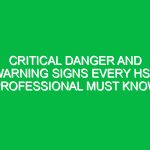Introduction
Hello team! Today, we’re gathering for a crucial toolbox talk centered around an essential aspect of our daily operations: Sling Inspections. As we engage in lifting operations, ensuring the integrity of our lifting slings is not just a regulatory requirement; it’s a vital component of maintaining a safe workplace. Our focus today will be on understanding what Sling Inspections entail, why they are necessary, how to conduct them effectively, and the consequences of neglecting this critical Safety measure.
What Are Sling Inspections?
Sling Inspections refer to the systematic evaluation of lifting slings used in various operations to ensure they are in safe working condition. These slings can be made from different materials—such as wire rope, chain, or synthetic fibers—and serve the crucial function of lifting and transporting loads. Regular inspections help identify wear, damage, or any other issues that could compromise Safety.
The Importance of Sling Inspections
Why are Sling Inspections so important? The answer lies in the risks associated with lifting operations. Faulty or damaged slings can lead to accidents, injuries, and even fatalities. Here are some key reasons why inspections are vital:
- Preventing Accidents: Regular inspections help identify issues before they lead to catastrophic failures.
- Compliance with Regulations: Many Workplace Safety regulations mandate regular inspections of lifting equipment.
- Maintaining Equipment Integrity: Inspections extend the lifespan of slings and other lifting equipment by ensuring they are maintained properly.
- Promoting a Culture of Safety: Regular inspections underscore our commitment to safety, encouraging everyone to prioritize health and safety.
Key Components of Sling Inspections
During a Sling Inspection, several key components must be evaluated. Here’s what you need to look for:
- Visual Inspection: Begin with a thorough visual check for any obvious signs of wear and tear, such as fraying, cuts, or abrasions on the sling material.
- Check for Deformation: Look for any bends or twists in metal slings, as these can significantly weaken the sling’s strength.
- Inspect Fittings and Hardware: Ensure that hooks, rings, and other fittings are free of cracks and wear. They should operate smoothly without any obstruction.
- Load Capacity: Always verify that the sling is being used within its rated load capacity to avoid overloading.
- Manufacturer’s Recommendations: Always refer to the manufacturer’s guidelines for specific inspection requirements and intervals.
Procedure for Conducting Sling Inspections
To conduct effective Sling Inspections, follow these steps:
- Preparation: Ensure you have all necessary tools and documentation, including inspection logs and manufacturer specifications.
- Visual Check: Perform a detailed visual inspection of the sling and all its components.
- Functional Test: If applicable, conduct a functional test to ensure the sling operates correctly.
- Documentation: Record your findings in the inspection log, noting any issues and the actions taken.
- Report Issues: Immediately report any issues to your supervisor to take necessary action.
Common Hazards Related to Sling Inspections
While performing Sling Inspections, it’s crucial to be aware of potential Hazards. Here are some common risks:
- Heavy Loads: Always be cautious when working around heavy loads that may shift unexpectedly.
- Environmental Factors: Be mindful of weather conditions, particularly in outdoor settings that may affect sling integrity.
- Inadequate Training: Ensure that all personnel conducting inspections are properly trained and understand the inspection process.
- Distractions: Maintain focus during inspections to avoid missing critical details.
Real-Life Examples
Understanding the importance of Sling Inspections can be highlighted through real-life scenarios. For instance, consider a situation where a team was preparing to lift a heavy load with a damaged sling. The operator noticed fraying during the inspection, which led to the decision to replace the sling. This proactive measure avoided what could have been a severe accident.
On the contrary, there have been cases where teams skipped inspections due to time constraints, resulting in sling failure during Operation. This incident led to injuries and significant downtime for the company. Such events emphasize the necessity of adhering to inspection protocols.
Best Practices for Sling Inspections
To ensure thorough and effective Sling Inspections, consider these Best Practices:
- Regular Training: Provide ongoing training for all team members involved in lifting operations.
- Establish a Schedule: Create a regular inspection schedule to ensure no sling goes unchecked.
- Use Checklists: Utilize inspection checklists to standardize Procedures and ensure consistency.
- Involve the Team: Encourage a team approach to inspections, allowing for multiple perspectives on sling condition.
- Promote Reporting: Foster an Environment where team members feel comfortable reporting issues without fear of reprimand.
Compliance and Regulations
Compliance with safety regulations is non-negotiable. Various organizations, including OSHA (Occupational Safety and Health Administration), have established guidelines regarding the inspection and Maintenance of lifting equipment. Understanding these regulations is vital for maintaining safety Standards and avoiding legal repercussions. Regular Sling Inspections not only fulfill compliance requirements but also demonstrate a commitment to Workplace Safety.
Engagement and Discussion
Now that we’ve covered the fundamentals of Sling Inspections, I’d like to open the floor for discussion. Here are a few questions to consider:
- What are some challenges you have faced during Sling Inspections?
- Have you ever encountered a situation where an inspection prevented a potential accident? What happened?
- What additional resources do you think could help enhance our Sling Inspection procedures?
Feel free to share your thoughts and experiences; it’s through open dialogue that we can continue to improve our safety practices.
Conclusion
In summary, Sling Inspections are a critical aspect of our daily operations that can significantly impact Workplace Safety. By adhering to inspection protocols, understanding the importance of compliance, and engaging in continuous training, we can prevent accidents and foster a culture of safety. Thank you all for your attention and commitment to ensuring a safe working environment. Remember, safety is everyone’s responsibility, and your diligence in conducting Sling Inspections is vital to our collective success.


